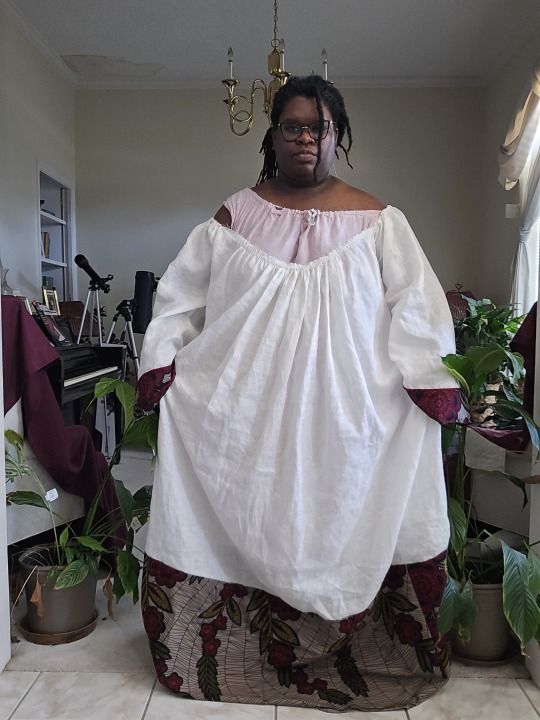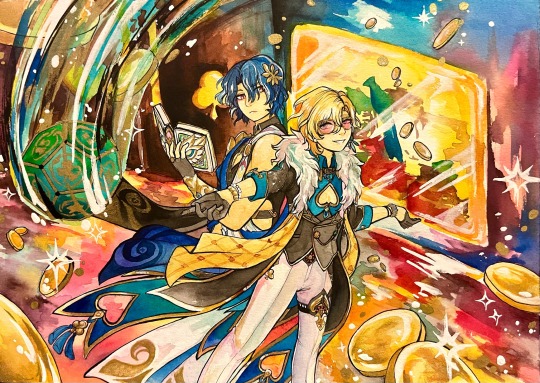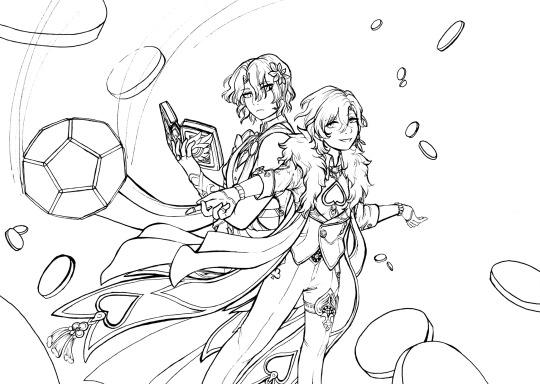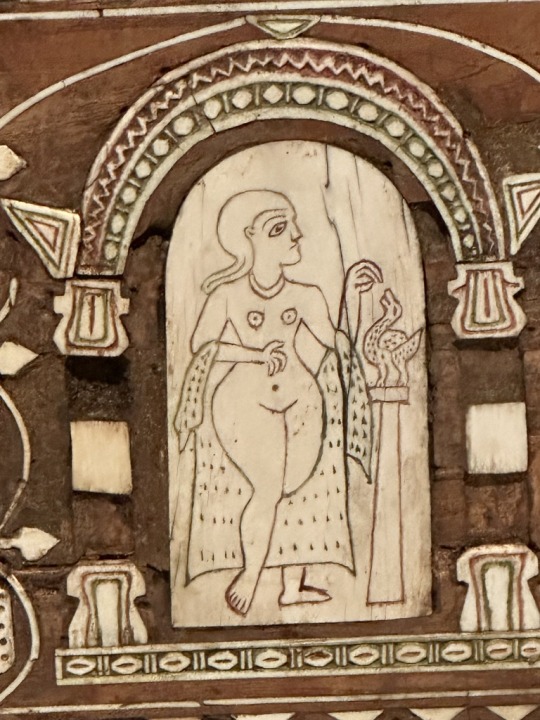#medieval africa
Explore tagged Tumblr posts
Text

head of a ram (pendant) | c. 1400s-1600s | owo kingdom (modern day nigeria)
in the nelson-atkins museum of art collection
62 notes
·
View notes
Text
129 notes
·
View notes
Text
Chemise -> Medieval Nubian Kaftan? Part 3
Part 1 Part 2
Okay so, I went with option 4 (Gather the neckline and bind it, then separately gather the shoulders with elastic). I gathered the neckline, added elastic to the shoulders, and just tried the Kaftan on to see how much I need to gather the necklines down actually.
I think I'll gather both down to 15" and see where we go from here.


Also the kaftan is too long, though gathering up the neckline will help with that. If that's not enough, I'll add a few pintucks right above the ankara hem, because I don't want to take away from hem, and do the same with the sleeves.
After that it's onto the cutting and hemming the ankara wrap. I wish I had an approrpiate fabric with better drape as ankara is a medium-weight cotton with quite a a lot of crisp body, and the paintings show these robes, caftans, and wraps in rather drapey fabrics, but I will save that for when I revisit this project.
A reminder of our inspiration:


#historical sewing#medieval africa#nubia#african christisanity#historybounding#historical dress#historical fashion#dress history
20 notes
·
View notes
Text

Painting I made a year ago, depicting a Sub Saharan African tribal leader; Both a merchant and a warrior. Hope you like it!
Best, JCH
www.joelchaimholtzman.com
#dungeons and dragons#board games#concept art#tabletop games#fantasy art#digital painting#magic the gathering#character design#ancient history#africa#african history#arab#berber#amazigh#medieval africa#medieval arab#arab history#arab mythology#african mythology
66 notes
·
View notes
Text
okay so I am currently reading NUBIA, ETHIOPIA AND THE CRUSADING WORLD, 1095-1402 by Adam Simmons and WE HAVE A DRAGON SIGHTING:
...in 1267, Roger Bacon continued to discuss dragons flying to Ethiopia from Latin Europe and told how dragon meat was used as a remedy for old age in his influential OPUS MAJUS amongst multiple pages of supposed information on 'Ethiopia'. MIGRATORY DRAGONS! But wait - there's more! Here's the relevant endnote for this passage: The passage regarding dragons being a secret to living a long life and increasing intelligence, which is why 'Ethiopians' come to Latin Europe to fly them back, is on II:211 (Bridges text); II:624 (Burke trans.)
OK so (a) where is my historical Norse fantasy featuring Black dragon riders coming to tame the dragons and ride them home to 'Ethiopia' (not the modern Ethiopia but Nubia, which today is in Sudan) and (b) I have to find out more about this stay tuned
#history#historical fiction#medieval history#black history#medieval africa#medieval fantasy#historical fantasy#dragons
116 notes
·
View notes
Text

Medieval Nubian Fashion ✦ Source
#medieval#medieval period#medieval fashion#medieval wear#medieval wardrobe#medieval dress#medieval africa#medieval nubia#nubia#nubian#medieval nubian fashion#nubian fashion#dress#fashion#wear#wardrobe#middle ages
3 notes
·
View notes
Text
Resources and Power: The Global History of Resource Monopoly and Inequality - Medieval Africa (Gold, Salt, and Trade Routes) 2024-10/20
Resources and Power: The Global History of Resource Monopoly and Inequality - Medieval Africa (Gold, Salt, and Trade Routes) 2024-10/20
Resources and Power: The Global History of Resource Monopoly and Inequality �� Medieval Africa (Gold, Salt, and Trade Routes) 1. Summary Overview In medieval Africa, empires like Mali and Ghana used gold and salt to build vast networks of power and wealth, controlling key trade routes across the Sahara. This resource monopoly not only empowered these kingdoms but also entrenched inequality,…
#Corporate Control#Economic History#Education Global Power Structures Series#global inequality#Gold Control#Mali Empire#Medieval Africa#Modern Monopolies#Resource Monopoly#Salt Trade#Trade Routes
0 notes
Text




My style guides for 0C Core! I was going to try and hand-illustrate my entire novel (Grim Inquiries), but I've decided instead to use the idea for cover art instead. If you'd like to draw fan art, here you go! I hope this helps.
#celtic art#comics#soul reaper#0C Core#concept art#medieval#middle ages#medieval africa#grim inquiries
1 note
·
View note
Text

The Storming of Bizerte (Orlando Furioso) by Gustave Doré
#gustave doré#art#orlando furioso#ludovico ariosto#medieval#middle ages#knights#knight#chivalric romance#chivalry#europe#european#christian#christianity#mediaeval#armour#city#siege#sack#sacked#bizerte#biserta#north africa#mediterranean#storm#lightning#thunder
246 notes
·
View notes
Text

Fragment of a Woodblock Print on Linen. The Cleveland Museum of Art.
From the Mamluk Sultanate of Egypt. 1200s/1300s.
#art#culture#history#middle eastern history#african history#north africa#North African history#egyptian history#egypt#mamluk#mamluk dynasty#the Cleveland museum of art#museum#medieval#medieval history#mamluk sultanate
173 notes
·
View notes
Text
Sculpture of a Woman with Four Children, from Mali, c.1100-1450 CE: this sculpture was created in the ancient city of Djenné-Djenno

Created during the 12th-15th centuries CE, this sculpture depicts a woman sitting cross-legged on the ground, with two children on her lap and two more clinging to her back. Scarification patterns are visible on the woman's temples, and there is a thick, undulating line running from her forehead to the nape of her neck, likely representing a serpent.

As this article explains:
Snakes on Inner Niger Delta sculptures are a common element and should be seen as a positive iconographic component. They represent control of a potentially dangerous benevolent power that must be tamed, domesticated, nourished, and satisfied so it will continue to provide protection.
This is one of the many terracotta sculptures that were produced in Djenné-Djenno, located in the Niger River Valley of Mali, in West Africa; Djenné-Djenno sits just to the south of the Medieval city of Djenné, which is still a major center of Islamic scholarship.

The ancient city of Djenné-Djenno dates back to at least 250 BCE, making it one of the oldest cities in West Africa. For centuries, it also served as one of the largest urban centers/trading hubs in the region, with a peak population of about 20,000 people. The city began to decline in the 9th century CE, when residents (and trade) began moving northward to the nearby city of Djenné, which had just recently been founded by Muslim traders. Djenné-Djenno was ultimately abandoned by the end of the 15th century.
Unfortunately (and unsurprisingly), most of the artifacts from Djenné-Djenno were looted or destroyed by colonizing forces during the 19th-20th centuries. Some of those artifacts have been repatriated in recent years, and there are ongoing efforts to return more of them.
Why Western museums should return African artifacts.
Sources & More Info:
Yale University Art Gallery: Female Figure with Four Children
World History Encyclopedia: Djenné-Djenno
Tribal Art: Scrofulous Sogolon (PDF)
ArtNews: Museum of Fine Arts Boston to Return Terra-Cotta Figures from Mali in Latest Restitution Efforts
CBS: African Nations Want their Stolen History Back, and Experts Say it's Time to Speed up the Process
Fair Observer: It is Now Time for the West to Return African Art
#archaeology#artifact#history#anthropology#dogon#djenne-djenno#mali#west africa#medieval art#sculpture#art#motherhood#children#djenne#african art#african history#repatriation#inner niger valley#terracotta#conservation#timbuktu
47 notes
·
View notes
Text
Lluna concept art!

Her summer tan is so epic! (This is how she would look in the current part of the story we are now since it’s just past summer and she was traveling under the sunlight for weeks)




My OC Lluna and her Iberian lynx Safiyyah 🩵💙
The Tifinagh lettering is just me scribbling her name in different ways. And I think Safiyyah’s would be best written as ⵙⴼⵢⴰ
The Arabic is more or less her Islamic name “Qamara al-Balansiyyah bint al-Mualim Shaar al-Ghabi” (al-Ghabi being the non-Islamic component, as it is her Christian mom’s surname translated)
The indigo blue represents part of her heritage; Tuareg Amazigh. The blue scarves are called Tagelmust, and they’re more than just scarves. They’re super interesting, and will be further explored in the story. (Kel Tagelmust are the men who wear them, and cover their face with them only leaving the eyes, here Lluna is just wearing one as a hijab.). Now, Amazigh use silver, rather than gold for jewelry, but I love golden so much, so what you see here is brass.
She is holding a ribbon that she embroidered herself, with a poem from Wallada bint al-Mustakfi. She also has henna not just in her hands but chin and brow.
This started out as a dress design, not really tied to the story. I wanted to make a dress with Zellige tiles incorporated in the design. Then I doodled a girl who ended up turning into Lluna. Which looked more like this beforehand, although probably with black hair. Tbh I didn’t imagine the hair as hers was originally completely covered up.

The Tagelmust will play a role in a future scene with Baldwin! I’m excited to write all these details, they’re always my favorite part 🥲
Follow me on insta if you like (I still don’t post much as I’m trying not to use social media too much):
@/baudouinette & @/alandalusica
#original charater art#king baldwin x oc#concept art#Tuareg#amazigh#medieval#oc art#my oc#koh fandom#oc commissions#kingdom of heaven#wallada bint al mustafki#lynx#iberian lynx#al andalus#Andalusi#zellige#henna#north africa
22 notes
·
View notes
Text
Chemise -> Medieval Nubian Kaftan? Part 4
Part 1 Part 2 Part 3
Okay so final product(ish)!


I ended up not adding the tucks because I just didn't have time to do it the way I want to before the party: carefully ironing and pinning each tuck and matching the sleeves. There was too much cooking and setup to do and the wrap helped pull the hem off the ground just enough for the night (not enough though). Either way I loved the end product and the medieval faire Christmas party was quite fun!


Because this is going to be my Christmas dress as well, I am going to overdye it red and see how it fits after it dries, I expect 5-8% shrinkage based on the linen and cotton. If it still needs tucks then, I will add them.
Also, I *will* be revisiting this project with a few changes to better represent the garments in the Faras paintings.

I need a different pattern to match the neckline. Though the paintings are very faded, we can see that the neckline is more crew/jewel than the open square neckline of the Italian chemise tutorial I followed.
I want to try cuffed balloon sleeves like the image on the right
The wraps don't look to be long rectangles but come to an angle on the ends. I will do more research and experimentation there.
The most important aspect is fabrication: fabrics with both body and drape would accomplish the silhouette in the images better. I'm thinking cotton-silk, linen-silk or linen-rayon blends. The most affordable options are probably rayon damasks.


#historical sewing#medieval africa#nubia#african christisanity#historybounding#historical dress#historical fashion#dress history
20 notes
·
View notes
Text

Golden Hour (+ lineart below cut)
I took a picture of the lines for once and did some basic crappy photo editing on my phone, so you could probably print this out and use it as a coloring page or something if you so wish lol. Do with it what you will.

#honkai star rail#dr ratio#veritas ratio#aventurine#aventurine hsr#cherallart#as you can see i forgor i wanted to draw his glasses til like. last second#i can’t believe it’s been like 2 whole months since I last did a whole like. watercolor illustration#part of that’s been bc I’ve been having a bit of a rough semester bc adhd med issues (which are resolved now)#but I really wanted to draw aventurine and ratio. my boys#i’ve been LOVING penacony so far so I needed to get something nice out#anyway I did this while my s/o and I alternated between reading a 500 pg long history book out lout to each other#it’s called ‘the inheritance of rome’ and kinda covers what happened after the collapse of the western roman empire#and tries to identify and explain all the cultural echoes and reverberations and transformations that rose from its ashes#throughout europe north africa and the middle east. anyway it’s super interesting and I highly recommend it#the late antique period is not something often covered/talked abt in public ed hist classes. at least not when I was goin through em#or the transitory period between it and the early medieval period at least#i still got 150 pages left and a final paper due on it in like 4 days but it’s only a 5 pg minimum and I’m a wordy bitch so#i think i can make it#anyway back to that I go
114 notes
·
View notes
Text












The Metropolitan Museum of Art, Africa and Byzantium
#art#art history#archaeology#academia#anthropology#museum#medieval art#ancient#ancient art#byzantine art#the metropolitan museum of art#africa and byzantium#africa#coins#textiles#painting
34 notes
·
View notes